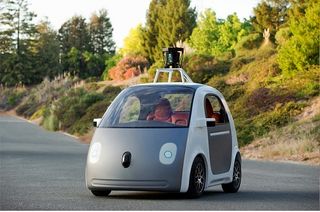Google's autonomous cars soon to be tested on public roads
The search giant's driverless cars could drastically reduce accidents, says project chief

Google's purpose-built driverless cars will be tested on public roads surrounding the search giant's US headquarters this summer.
This is the first time the vehicles have been tested on public roads, with them previously designed to test tracks without contact with traffic.
A select few prototypes will be tested on ordinary roads with the assistance of Google's safety drivers, as per the company's announcement.
In a video posted on Google's blog, systems engineer for the project, Jaime Waydo, said: "Every moment has been building towards putting these cars on the roads where we can start learning even more from them.
"Getting these cars out in to the public and allowing people to react to them, allowing us to see them out there, that's a huge deal and most importantly it's a necessary step to getting them to drive themselves," project head Chris Urmson added.
The vehicles have already been through extensive reliability and durability testing before reaching this point, with nearly a million autonomous miles logged since Google started the project. In terms of safety, each of the cars' speed will be capped at 25mph.
Business correspondent Thea Leggett told the BBC: "The company has shown that autonomous cars can run reliably on well-mapped and predictable routes, but they are a long way from being able to cope with the unprogrammed chaos of a city centre at rush hour.
Get the ITPro. daily newsletter
Receive our latest news, industry updates, featured resources and more. Sign up today to receive our FREE report on AI cyber crime & security - newly updated for 2024.
"So the transition to driverless technology is likely to be a gradual process, with the role of the human at the wheel becoming less important over time."
Recently, it was revealed that a fleet of 20 self-driving Google cars have been involved in 11 accidents, though the company was quick to attribute them to human error, pointing out that, with an average of 10,000 miles driven every week, the ratio of accidents to miles is not that high.
Urmson said that one of the advantages offered by self-driving car technology is reducing accidents.
"Vehicles that can take anyone from A to B at the push of a button could transform mobility for millions of people, whether by reducing the 94 per cent of accidents caused by human error, reclaiming the billions of hours wasted in traffic, or bringing everyday destinations and new opportunities within reach of those who might otherwise be excluded by their inability to drive a car," he said.
He added: "We're looking forward to learning how the community perceives and interacts with the vehicles, and to uncovering challenges that are unique to a fully self-driving vehicle - e.g., where it should stop if it can't stop at its exact destination due to construction or congestion.
"In the coming years, we'd like to run small pilot programmes with our prototypes to learn what people would like to do with vehicles like this."
Caroline has been writing about technology for more than a decade, switching between consumer smart home news and reviews and in-depth B2B industry coverage. In addition to her work for IT Pro and Cloud Pro, she has contributed to a number of titles including Expert Reviews, TechRadar, The Week and many more. She is currently the smart home editor across Future Publishing's homes titles.
You can get in touch with Caroline via email at caroline.preece@futurenet.com.





